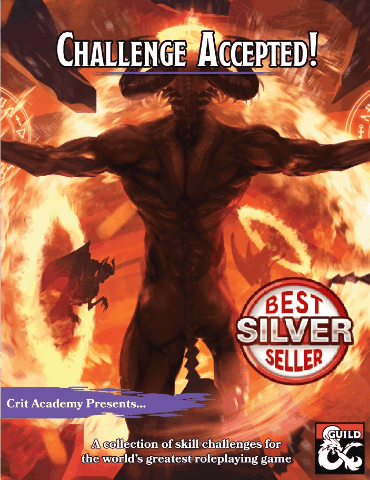Roleplaying and Non Combat Encounters
- Justin Handlin

- Jan 3, 2020
- 5 min read

Crit Academy discusses how to get the most out of roleplaying and non combat encounters in Dungeons and Dragons. We break into improv roleplaying and act how some of these interactions can unfold. Roleplay takes on many forms such as simple changes in pitch and tone or mannerisms.
Unearthed Tips and Tricks: New and reusable D&D content for you to bring with you on your next adventure.
Character Concept:
The un-familiar is a powerful mage who has been polymorphed into an animal that is
commonly used as a familiar (such as an owl or toad). This curse keeps her trapped in a beast
form, and she’s been searching for a way to break the spell ever since. She is so ashamed of
her form that she has come to live vicariously through the bodies of others. She accomplishes this by using mind-control to force her victims into doing her bidding. The people she steals become the wizard, and she disguises herself as their familiar whilst secretly running the show.
As each body starts to get more and more worn out, it might be necessary to source a new
physical form. You’ll have to ditch the body somewhere secret, and pick up a replacement
in a suitably sneaky fashion! You’ll also have to come up with a reason for your frequently
changing appearance. For example, you might claim to be a shifter.
Once the party discovers the truth, they might be faced with a moral dilemma. How
do they feel about you stealing people from their lives? Are you using the party to find
a cure for your curse, or do you enjoy their company?
Encounter Concept:
The Innocent
In this scenario, a rash of murders has been wracking a community. People are turning up
dead left and right, and a serial killer or some kind of deadly monster is suspected. The players are hired to investigate and find the killer, and when they follow the clues it turns out that the killer… is a young child who seemingly has no knowledge of how or why the murders have been taking place.
The Innocent might be mind-controlled by a powerful enchanter or possessed by a demon.
Maybe the child simply has some kind of supernatural power paired with insanity that causes them to murder. Whatever the case, the party has a moral conundrum to deal with.
The town might want the child killed; they did commit these murders, after all. However,
would a Lawful Good Paladin see the child as guilty, or would they try to keep the child safe
from those that wanted blood? Even if they’re able to determine that an outside source is to
blame, how do they keep the child safe while also finding the enchanter or searching a way
to exorcise the demon? What if, in the end, it turns out that the child itself IS actually
the responsible party, can the players justify slaughtering a child?
Magic Item:
The Immovable Hammer
This Hammer has a button on one end. You can use an action to press the button, and cause the hammer to become magically fixed in place. Until you or another creature uses an action
to push the button again, the hammer doesn’t move (even if it is defying gravity). The ammer can hold up to 8,000 pounds of weight. More weight causes the hammer to deactivate and fall. A creature can use an action to make a DC 30 Strength check, moving the fixed hammer up to 10 feet on a success.
Additionally, this hammer allows the wielder to knock the target prone on a critical hit,
and keep them immobile for as long as the hammer is activated. If a creature uses its
action to examine the hammer, the creature can determine that there is a button on the handle with a successful Intelligence (Investigation) check DC 14. If the creature discerns the
hammers trick for what it is, they can use an action to press the button and remove it.
This hammer is built around an existing magic item: The Immovable Rod. The creator of
this item took an ordinary hammer, dismantled it, and replaced the haft with an Immovable
Rod, allowing the wielder to activate its Immovable quality by tapping a button on the
grip.
The uses of this hammer are as limitless as the wielder’s imagination - you can use it to
barricade a door, to give a player an anchor to tie a rope to so they can swing across a pit, to
aid in climbing by giving another handhold whenever one is needed, and so on.
DM Tip:
Check out this awesome Adamantine Best Seller DMsguild Supplement: Ancestral Weapons. We had the pleasure of covering this product when it released, and it really hits this DM tip perfectly.
Evolving Weapons:
Finding magic items in D&D is a lot of fun; not many people will argue that. However, not all
DMs like giving them out often - some want them to be rare and significant whenever they
appear. Rather than giving out a +1 sword, and then later giving out a +2 sword so the player
can chuck out that old +1, what if you gave out items that grow and develop as the players
perform epic feats of courage?
Imagine a hero who is gifted a sword forged by a fabled blacksmith who has passed away. Later, when he uses that sword to slay a red dragon terrorizing a town, something different happens. Maybe, with the final blow, the hero pierces the dragon’s heart, bathing the sword in its blood. After the great beast is slain, the hero lifts the sword and finds that the blade shines with an unearthly power. Its blade has become supernaturally sharp. Through killing this red dragon, the sword has become +1! Then, later on, the player uses the sword to kill a powerful ice giant that was trying to freeze the continent through an arcane ritual. Upon striking down the frozen giant, the hero finds the sword’s blade has become supernaturally cold, and now it functions as a +1 Frost Brand!
As a DM, you can let players’ weapons, armor, staves, and all kinds of magic items evolve as
they level up. The item might be an ordinary weapon that becomes magical as it is used to perform feats of greatness. It might be an item that already has a storied past but has been long forgotten, and as the players uncover its past it becomes a legendary artifact when it was originally used as a doorstop in the shopkeeper’s storage room. It lets DMs put a lot more work into fewer items to keep the total number of magic items low, but it also keeps players interested by making each item a deep and intricate character all on its own.
Player Tip: Don't be a Dick!
Come Prepared
If a DM came to a table and had nothing prepared for the session, you’d know it. You’d
have to sit around waiting for them to flip through books, and whenever they got the
adventure going they’d have to constantly check books to see how abilities and spells worked - it would probably seem like everyone’s time was being wasted. Preparedness isn’t just essential to DMs. As players, you should arrive at a gaming table with as much prepared as possible. This can articulate in lots of ways, including:
1. Bring your character sheet!
2. Bring your dice and pencils!
3. Remember where you left off last session!
As the mantra goes, don’t be a dick. Everyone is taking time out of their busy schedules to show up at the table, not just you. Accidents happen you’re going to forget your supplies or be unprepared once in a while - but if you’re actively trying to keep it from happening, it’ll happen less. We guarantee it.
Consider checking out our Best Selling Dmsguild Supplement: Challenge Accepted: A collection of skill challenges for your D&D games. It's a great way to enhance your table with non combat encounters.
We hope you enjoyed your experience here on Crit Academy, if you did, please consider sharing our show and leaving a review here on itunes.
Support Us:
Subscribe to our Blog and be entered to win phat lootz every week.
Visit our website at www.critacademy.com or become a patreon donor and get additional phat loot!















Comments